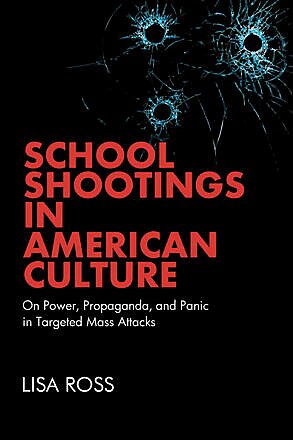
Digging Deeper into School Resource Officers: School Shootings in American Culture
In the wake of several devastating and highly publicized school shootings over the past year, the new book School Shootings in American Culture, by psychologist Lisa Ross, offers a timely examination of their underlying causes. Drawing on the history of school shootings and policy responses to them, Ross explores these events through the lens of centralized power, hyperconnectivity through various forms of media, and the role of “propaganda.” Together, this triad forms a nuanced framework for understanding why such tragedies occur and where current policies and practices fall short of protecting students.
School Shootings in American Culture opens with an anecdote of police officers arresting six-year-old Kaia Rolle, which segues into questioning an officer’s ability to appropriately respond to a child in distress. As noted in the book, the proliferation of police in schools is often due to legislation enacted in post-shooting atmospheres, where the intent is to mitigate and prevent future ones. But because emergencies are rare, the role of police in schools has expanded far beyond that of first responders, and, as Ross points out, the ambiguity between the responsibilities of school staff versus police may inadvertently increase students’ interactions with the criminal justice system. Ross also notes that zero-tolerance policies—mandatory, severe disciplinary actions intended to deter antisocial behavior—have been shown to be ineffective at changing school climate.
Ross then explores the role of the media in fueling panic after school shootings, from the amplification of news to the stylistic choices of journalists in presenting the information. She highlights how the repetition of certain narratives by the media might blur internal lines for viewers, leading them to believe that shootings are common and getting more so. Finally, Ross draws on early twentieth-century social theories to frame contemporary forms of propaganda perpetuated by media and institutional leaders, including Gustave Le Bon’s view that a leader can mobilize a crowd through emotionally charged ideas and Edward Bernays’s argument that leaders can exploit fear and social divisions—pitting groups against one another—to advance their own interests.
Ross adds that Hollywood provides relatable fantasies for people who might feel ambivalent about their interpersonal groups, whether that be school, family, or work. Ross posits that such a depiction of scapegoating for one’s problems—referencing Arthur Fleck in Joker—could reinforce an individual’s violent ideation if not mitigated by education to see beyond a black and white, good or bad, worldview.
Having written several times on School Resource Officers (SROs), I appreciated Ross’s examination of the research on SROs. We came to the same conclusion: the research is unclear and scarce and does not support sweeping laws that increase SRO presence. Though additional research may help clarify some questions about the consequences of having cops in schools, Ross points out ethical challenges to collecting such data: if one school is randomly assigned an SRO and another is not, and the non-SRO school suffers a shooting, many people—understandably—would object to such research, despite not knowing if the SRO would make a difference. But simply comparing schools that choose to have SROs versus those that do not would introduce selection bias. For instance, schools that choose to employ SROs might do so because they have higher crime rates.
Ross highlights a unique and often overlooked challenge SROs face in having to respond to shootings: they essentially must outsmart the person committing the shooting in real time. This is especially challenging when the person is a former or current student, which might mean they went through the school’s active shooter drills. Additionally, Ross points out that highly publicized accounts of incidents allow people to “learn” from others who have committed shootings, further challenging the ability of on-scene SROs to achieve their original objective.
Ross also highlights that schools and police agencies face incentives to increase the number of SROs when they are presented with grant money, often from the federal government, or laws mandating their presence. Grants could be especially problematic if they incentivize schools to hire whomever they can find to fill the job, potentially lowering standards for SROs. Such incentives shift power away from education institutions to law enforcement, highlighting the need for decentralized decision-making and local funding.
It would have been beneficial if Ross had discussed the constitutional implications of having police carry out law enforcement duties in schools. Because students generally have had little interaction with the justice system and are often unaware of their rights, there could be some serious encroachment of state power that goes largely unnoticed. This is especially true because some jurisdictions classify SROs as school officials, who only need reasonable suspicion to search students, while officers who work outside of schools need probable cause.
In jurisdictions where probable cause is required for SROs to search or interrogate students, some scholars have pointed out that this can be circumvented by the SRO merely asking school officials to question and search students. Unnecessary searches or other negative interactions with an SRO could be especially problematic for future police interactions.
Overall, Ross provides a comprehensive framework for understanding the motivations behind school shootings and a critical examination of responses to them. It is also timely, as SROs are becoming increasingly common but have generated relatively little discussion. As Ross points out, no proposed solution is a panacea, but it would be naive and inefficient to take a purely reactive approach, and it is important to reconsider policies that might cause more harm than good.
Though School Shootings lacks concrete solutions, it is a step in the right direction to understanding the multifaceted nature of this troubling problem.
